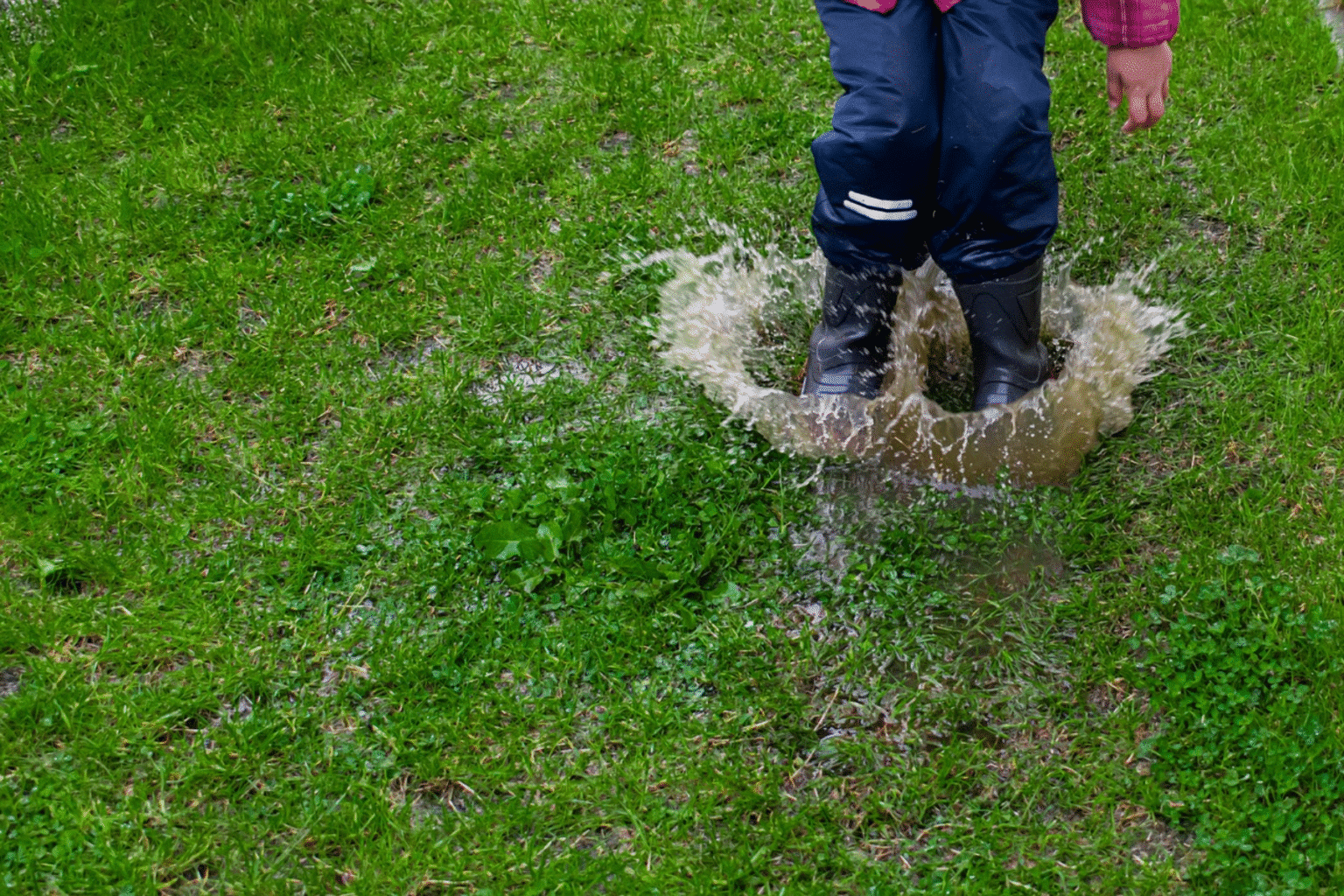If you’ve ever watched a summer downpour rush across your driveway or pool in your backyard, you’re not alone. Here in St. Louis County, we know how quickly heavy rains can overwhelm yards, streets, and storm drains.
The good news? You can fight back—with smart stormwater landscaping.
Rain gardens, bioswales, and bioretention systems are beautiful, functional landscape features that help manage stormwater right where it falls. Whether you’re building a new home, managing drainage, or just want a more eco-friendly yard, this guide will help you choose the right option and understand what makes it work.
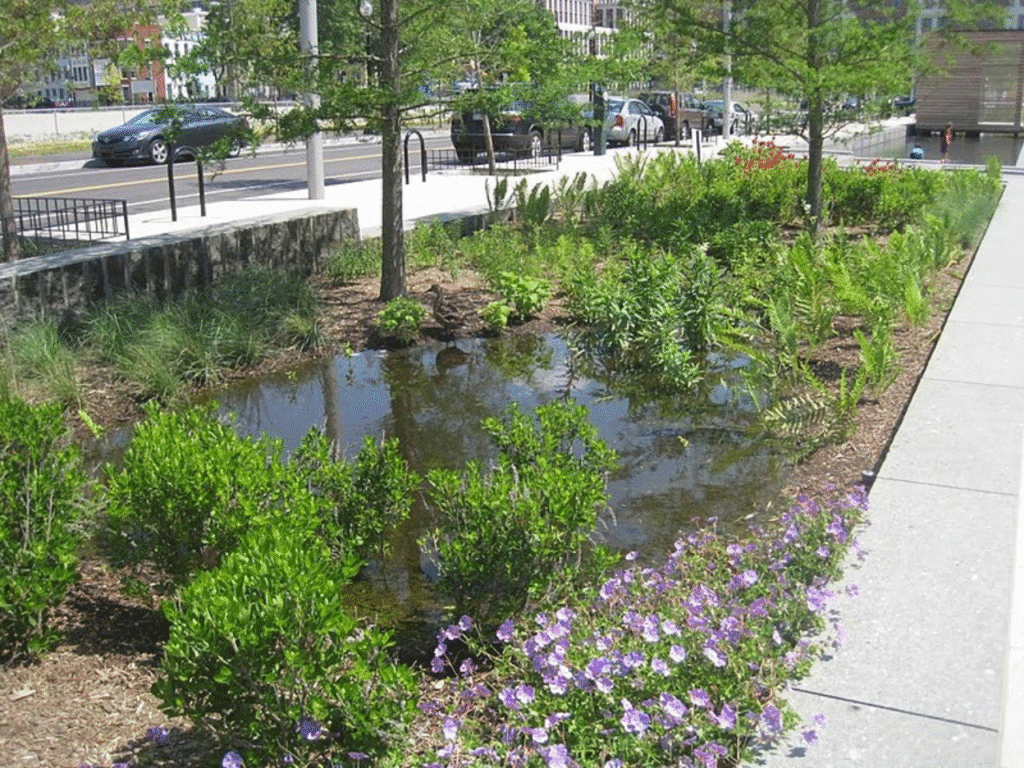
What’s a Rain Garden? (And How It Differs from a Bioswale or Bioretention System)
While these terms are often used interchangeably and all work toward the same goal—capturing and cleaning stormwater—they serve slightly different purposes:
Rain Garden
A rain garden is a shallow, bowl-shaped bed filled with deep-rooted native plants, designed to catch runoff from roofs, driveways, or patios. Rain gardens temporarily hold water and let it soak into the soil within 24–48 hours—reducing erosion and filtering out pollutants. These gardens are planted with native flowers, grasses, and sedges that thrive in both wet and dry conditions. These often just look like a beautifully landscaped bed—but it’s working much harder than that.
Bioswale
A bioswale is a gently sloped, vegetated channel that moves water across your yard while filtering it. It’s ideal for long driveways or sloped lots, where water needs help traveling safely from one area to another.
Bioretention System
This is a more engineered version of a rain garden, often required in commercial or new residential subdivisions. Bioretention areas include special soil blends, underdrains, and overflow structures to handle larger volumes of stormwater.
Despite the differences, they all help reduce runoff, filter pollutants, and protect local waterways—while offering a unique opportunity to beautify your yard with native plants.
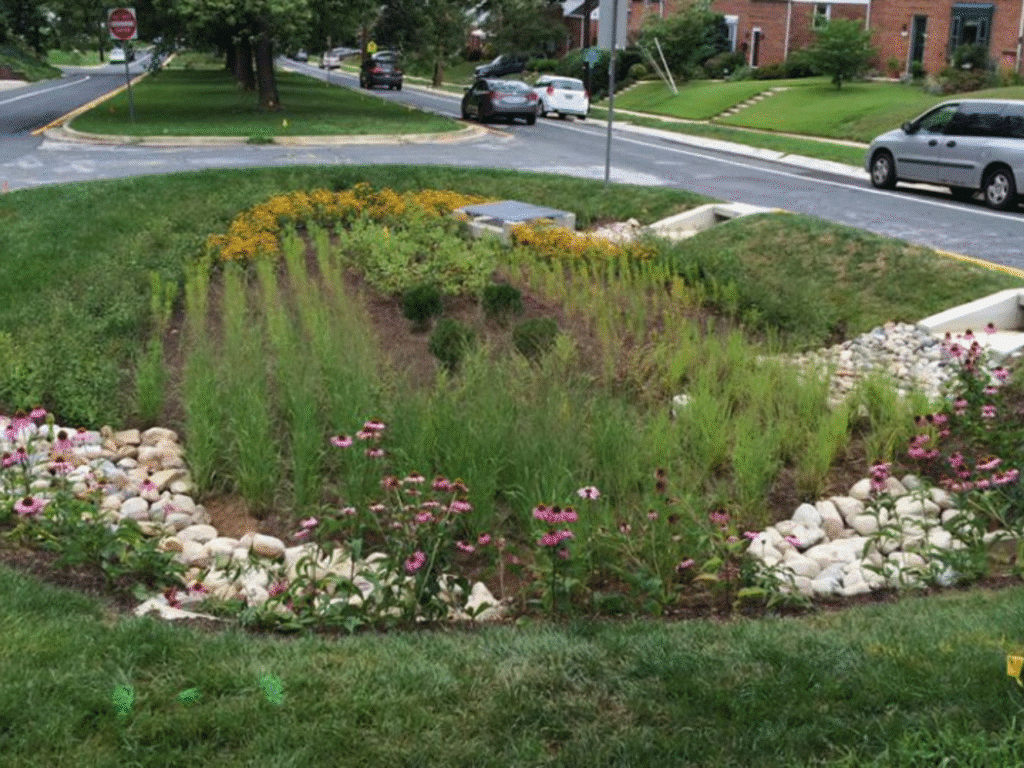
Why You Might Need a Rain Garden in St. Louis
If you’re in Chesterfield or other areas of St. Louis County, a rain garden or bioretention area may be required—especially if you’re building new, adding onto your home, or altering your drainage patterns.
Under Metropolitan St. Louis Sewer District (MSD) stormwater management rules, new construction must use Best Management Practices (BMPs) to mimic pre-construction runoff levels “to the maximum extent practicable.” And in Chesterfield, if your stormwater system isn’t maintained properly, it can legally be declared a public nuisance.
Even if you’re not required, there are plenty of great reasons to add one:
- Reduce runoff and standing water
- Control erosion and protect your foundation
- Filter pollutants before they reach creeks or rivers
- Support pollinators and beneficial wildlife
- Improve curb appeal and boost property value
- Qualify for MSD Project Clear grants or credits
Can You DIY a Rain Garden or Bioswale?
Yes—with the right site and some upfront planning.
Save the Bioretention Systems for the Pros
These require grading, special soil layers, underdrains, and must meet very specific guidelines. If your build requires one, our team can handle that for you from design to installation.
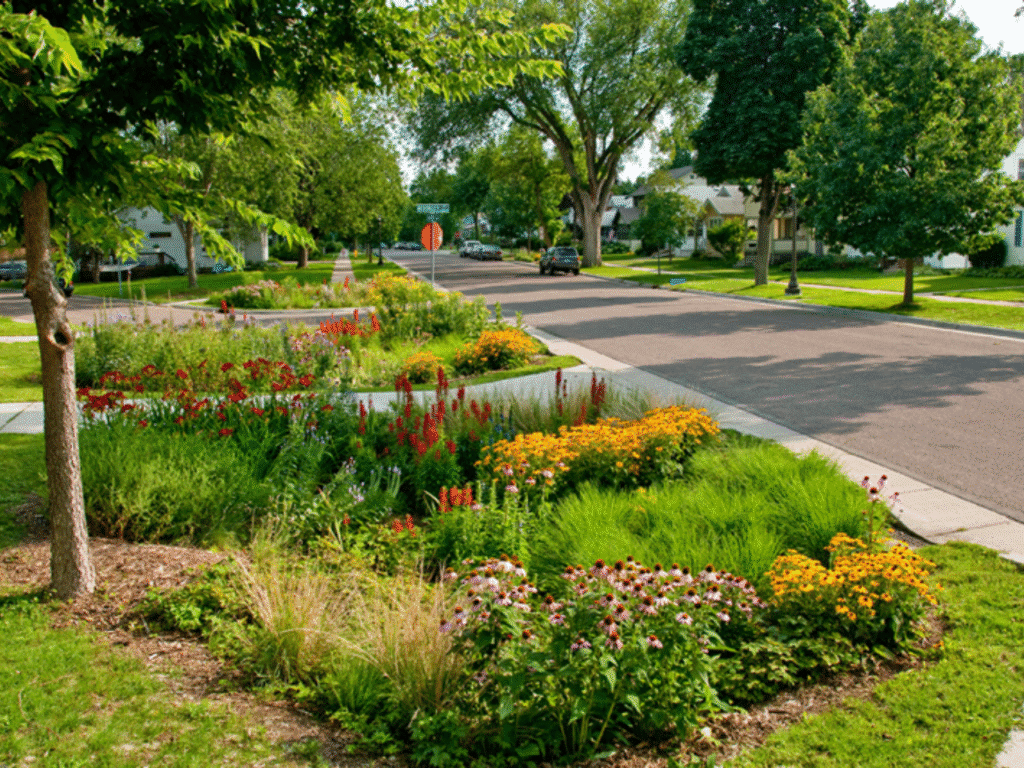
But Rain Gardens and Bioswales? Homeowners Can Do That
Here’s how to get started:
- Choose the right location
- At least 10 feet from your house
- On a gentle slope (1–2%) to direct water in
- Away from septic, buried utilities, or large tree roots
- Size it based on your drainage area
- A good rule of thumb: 1 square foot of rain garden per 10–20 square feet of impervious surface (roof, driveway, etc.)
- Excavate and improve the soil
- Dig 6–12 inches deep
- Amend with a mix of sand, compost, and native topsoil to aid infiltration
- Add an overflow outlet
- Even well-designed rain gardens can fill during big storms
- An overflow outlet is a small notch, swale, or pipe—set just below the rim—that safely channels extra water to a lawn, dry creek bed, or storm drain
- Without it, water could spill over and cause erosion or damage nearby structures
- Mulch wisely
- Use coarse shredded mulch that won’t float away during heavy rains
- Plant smart
What Makes a Rain Garden Work? The Plants
Plants are what make a rain garden work.
Rain garden plants:
- Have deep roots that break up clay soil and improve drainage
- Trap sediment and filter pollutants
- Help stabilize slopes and reduce erosion
- Provide food and habitat for bees, butterflies, and birds
MSD guidelines recommend grouping plants by moisture zones:
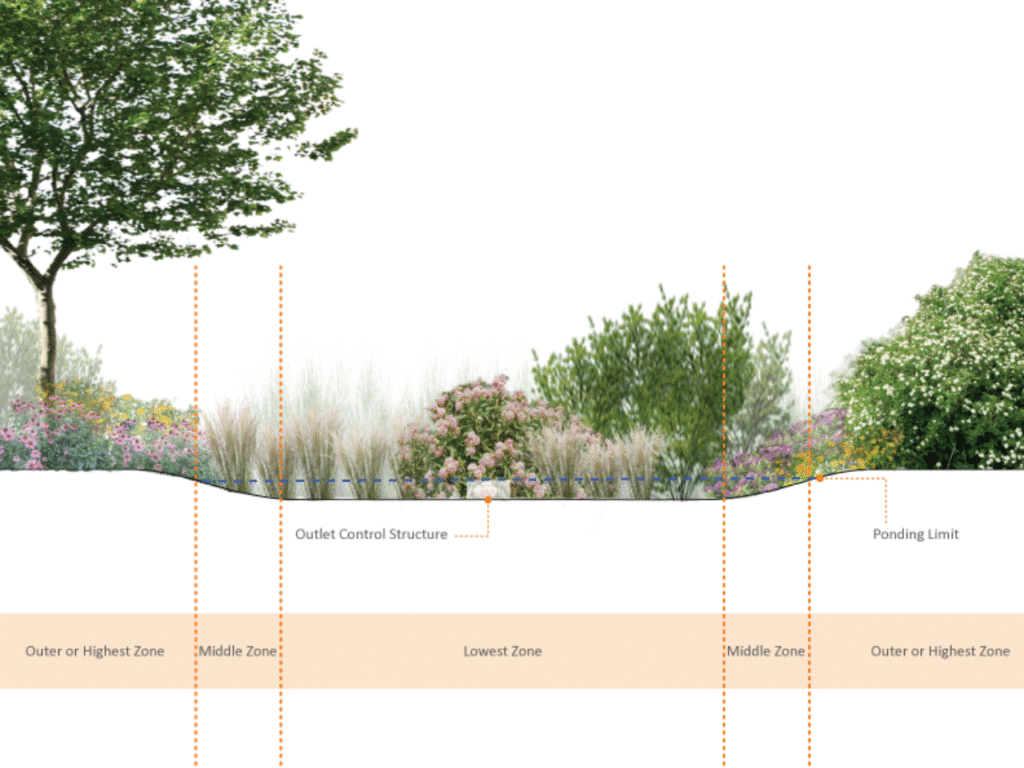
| Zone | Moisture Level | Ideal Plants |
| Bottom Zone | Consistently wet | Blue Flag Iris, Bur Sedge |
| Middle Zone | Moist/dry cycle | Short’s Sedge, Shining Bluestar |
| Edge Zone | Typically dry | Prairie Dropseed, Showy Goldenrod |
Grouping by zone ensures every plant is in a spot it thrives—without flopping, wilting, or overgrowing.
Favorite Plants to Keep Your Rain Garden Tidy
Rain gardens get a bad rap for looking “wild,” but these MSD-approved Missouri natives are dependable, structured, and low maintenance.
Sedges / Grasses
Deep-rooted, fibrous plants that slow water, trap sediment, and keep soil in place.
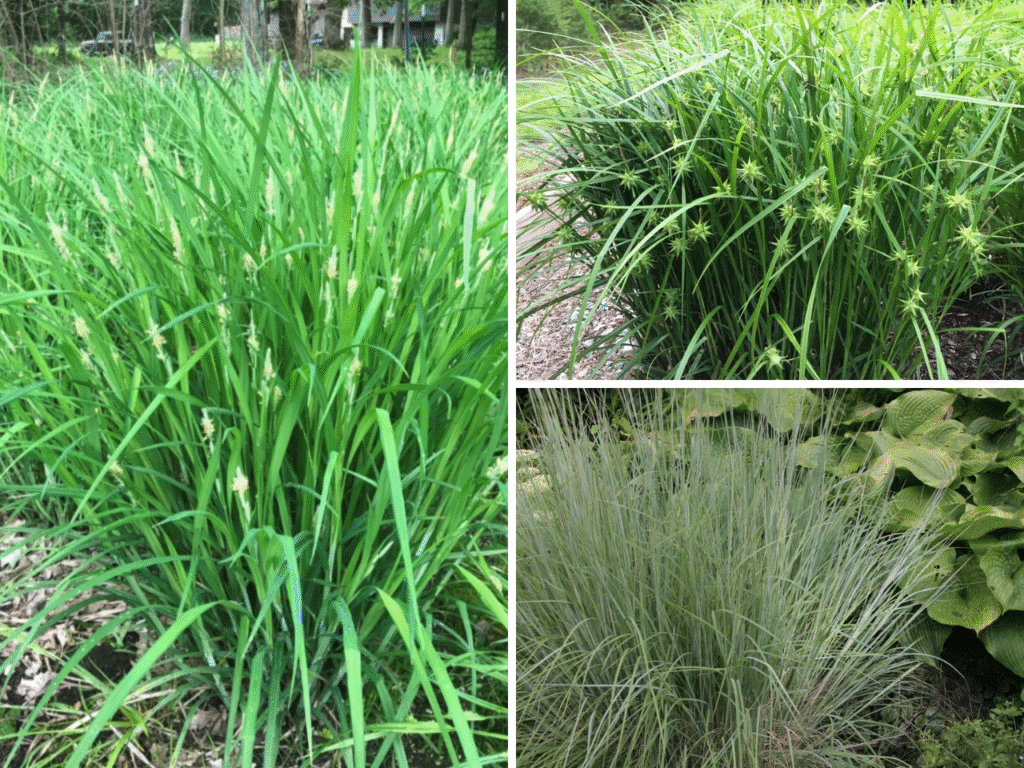
Bur Sedge (Carex grayii)
- Zone: Bottom zone (consistently wet)
- Tidiness: Clump-forming, tidy
- Landscape Bonus: Its distinctive star-shaped seed heads and clean form make it a standout in any shady or moist border—even without a rain garden.
Short’s Sedge (Carex shortiana)
- Zone: Bottom to middle zone
- Tidiness: Clumping and well-behaved
- Landscape Bonus: Blue-green foliage and graceful habit give it structure in mixed plantings. It handles moist soils but doesn’t mind it drying out occasionally.
Little Bluestem (Schizachyrium scoparium)
- Zone: Edge zone (typically dry)
- Tidiness: Upright, very tidy (if not flopped by fertility or shade)
- Landscape Bonus: Silvery summer foliage and stunning fall color make it a four-season gem, ideal for sunny slopes or dry garden beds.
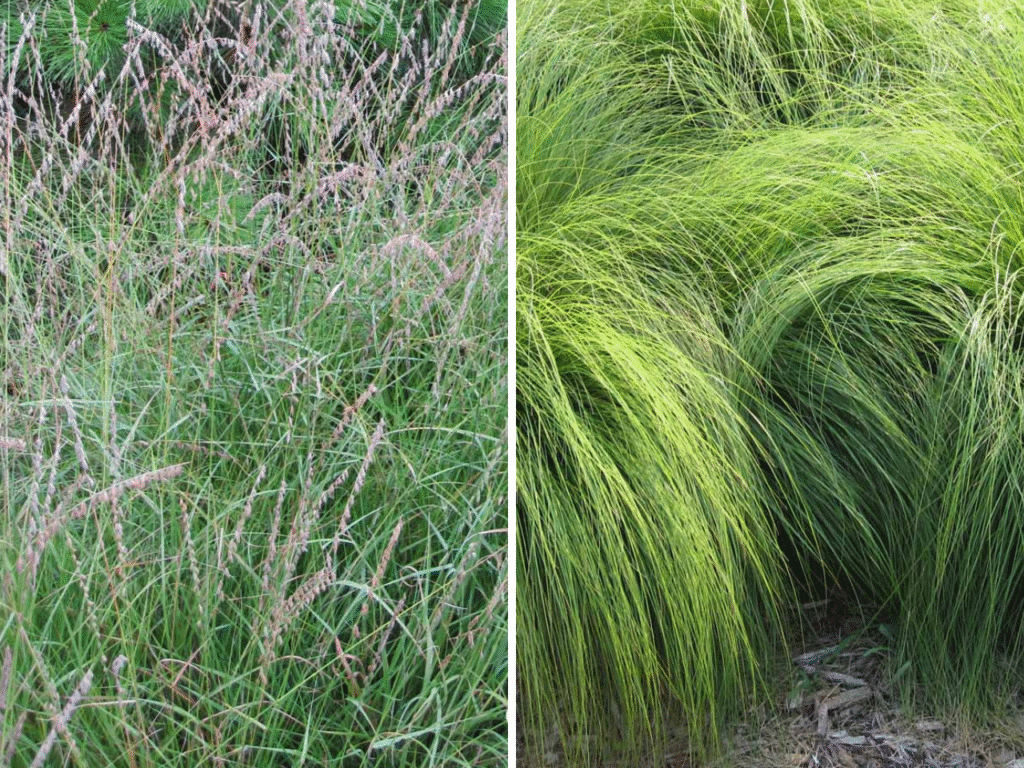
Sideoats Grama (Bouteloua curtipendula)
- Zone: Edge zone
- Tidiness: Neat and clump-forming
- Landscape Bonus: Whimsical dangling seed spikes and compact form work well in rock gardens, dry borders, and low-maintenance designs.
Prairie Dropseed (Sporobolus heterolepis)
- Zone: Edge zone
- Tidiness: Extremely tidy
- Landscape Bonus: This fine-textured native grass forms elegant, fragrant mounds. Use it in mass plantings, near patios, or flanking pathways.
Forbs
Flowering, pollinator-friendly plants that add color, structure, and seasonal interest.
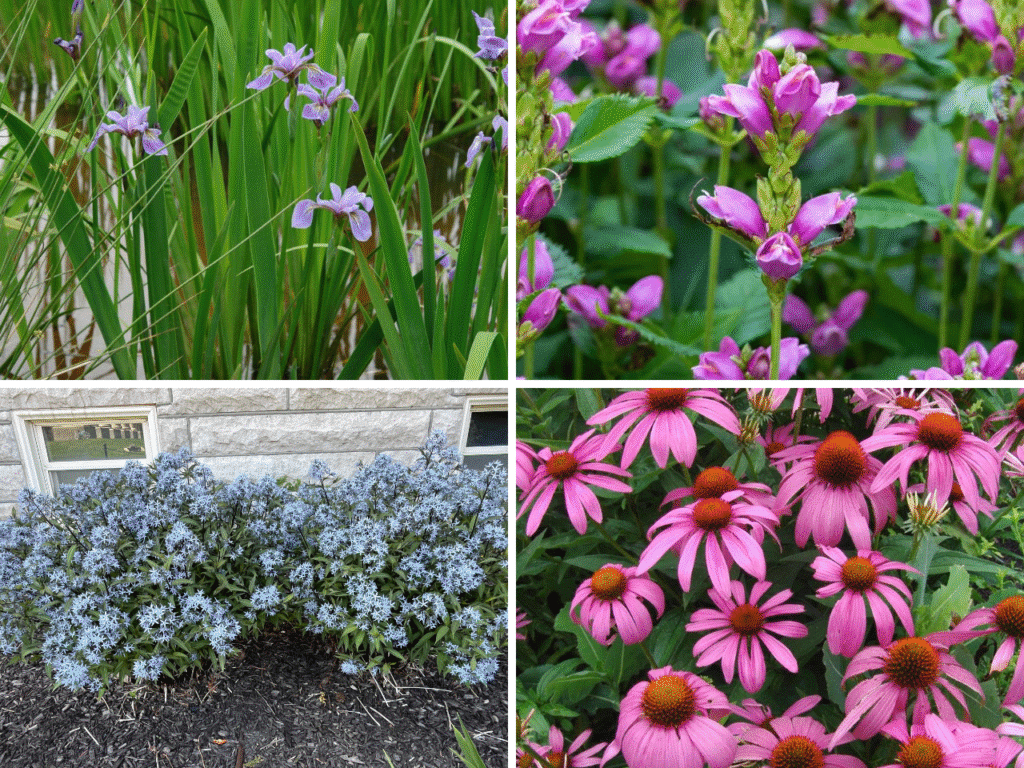
Southern Blueflag Iris (Iris virginica)
- Zone: Bottom zone
- Tidiness: Semi-tidy (rhizomatous but manageable)
- Landscape Bonus: Striking blue blooms and sword-like leaves bring bold texture to pond edges or sunny, moist beds—even with no rain garden in sight.
Rose Turtlehead (Chelone obliqua)
- Zone: Bottom to middle zone
- Tidiness: Tidy, upright form
- Landscape Bonus: Late summer color and glossy foliage make this an excellent choice for shady perennial borders with decent moisture.
Shining Bluestar (Amsonia illustris)
- Zone: Middle zone (moist to dry)
- Tidiness: Very tidy, shrubby habit
- Landscape Bonus: It’s a landscape designer’s dream—spring blooms, clean foliage, golden fall color. Looks great as a mass planting, edge of woodland, or accent.
Purple Coneflower (Echinacea purpurea)
- Zone: Middle to edge zone
- Tidiness: Clump-forming, neat
- Landscape Bonus: Pollinator favorite with months of blooms. Performs in sunny, average soils—no rain garden required.
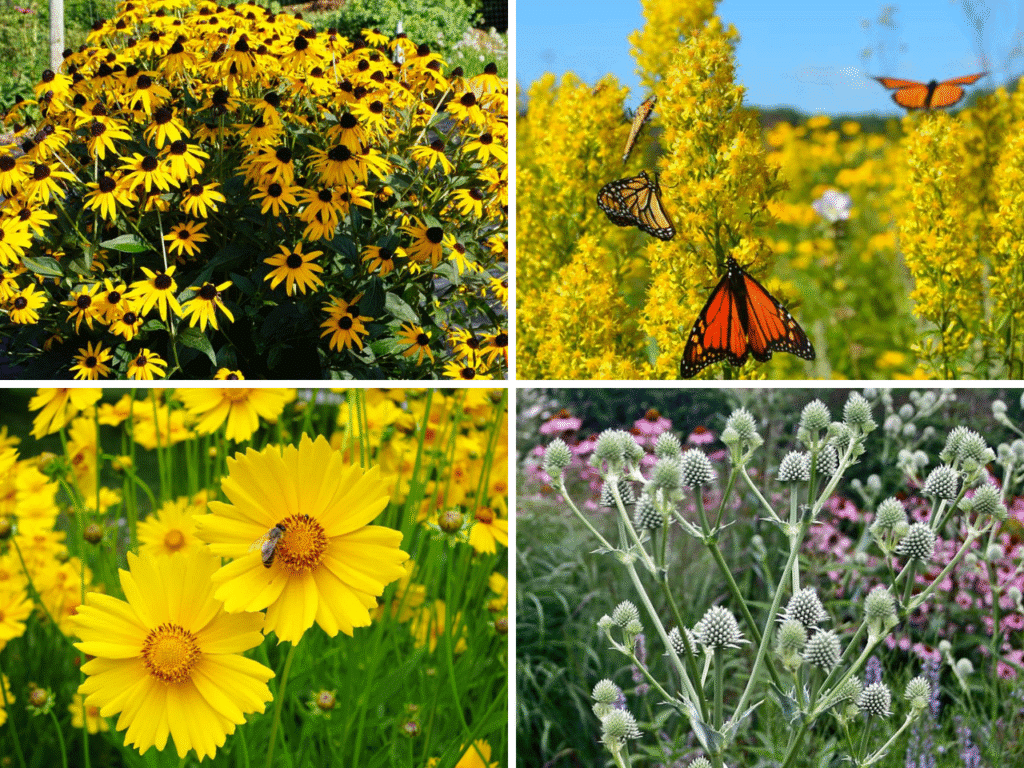
Orange Coneflower (Rudbeckia fulgida)
- Zone: Middle to edge zone
- Tidiness: Very tidy (compared to R. hirta)
- Landscape Bonus: Don’t be confused by the common name, you probably know this best as Black-Eyed Susan. A long-blooming workhorse for perennial beds and borders, especially when massed.
Showy Goldenrod (Solidago speciosa)
- Zone: Edge zone
- Tidiness: Tidy (clump-forming, not invasive)
- Landscape Bonus: One of the best goldenrods for gardens—no spreading chaos, just brilliant late-season gold for sunny spots.
Lanceleaf Coreopsis (Coreopsis lanceolata)
- Zone: Edge zone
- Tidiness: Very tidy
- Landscape Bonus: A long-blooming sunny yellow daisy for lean, dry soils. Perfect for pollinator gardens and no-fuss front yards.
Rattlesnake Master (Eryngium yuccifolium)
- Zone: Edge to middle zone
- Tidiness: Architectural and tidy
- Landscape Bonus: This prairie oddball draws attention with spiky blooms and yucca-like foliage—ideal for hot, dry gardens with a bit of attitude.
While all of these plants shine in the context of a rain garden, they don’t require one to thrive. Many are just as happy in garden beds, borders, meadow plantings, or foundation landscapes—offering structure, seasonal interest, and low-maintenance beauty across a variety of conditions.
Ready to Add a Rain Garden to Your Yard?
Whether you’re required to add a stormwater feature—or just want to make your yard smarter, healthier, and more beautiful—we can help.
At Baxter Gardens of Chesterfield, we design rain gardens, bioswales, and bioretention systems that look as good as they perform. Let’s work together to create a landscape that works hard and looks amazing.



